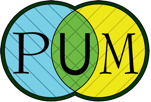
Physics Union Mathematics
PUM Details
The strengths the PUM curriculum is in the repeated process through which students acquire knowledge and abilities. Students begin each conceptual unit by observing simple, carefully selected phenomena (called observational experiments). They look for patterns in their observations. To find these patterns they analyze their observations using different representations, learning to reason in ways that are natural to their own learning styles. Then they devise qualitative explanations of these patterns. They then use their own explanations to make predictions about the outcomes of new experiments (called testing experiments). Based on the outcomes of their testing experiments, confidence in their explanation increases, or it needs revision, or it is rejected. For example, students hold a tennis ball and a medicine ball, one in each hand. They develop the idea of interactions—the hand exerting an upward push and the Earth pulling down. What about the air? They often feel it must push down more on the medicine ball. How can they test this hypothesis? The PUM video website offers them an experiment where an object is held by a spring under a vacuum jar. Students use their own hypothesis to make a prediction about the stretch of the spring when the air is pumped out of the jar. The spring should stretch less! But they observe that the spring stretches more and consequently revise their hypothesis.
This entire process is then repeated only this time using quantitative mathematical representations—using “progressive differentiation”, which involves a simultaneous focus on the structure of knowledge to be mastered and the learning processes of students. Following up on what the scale supporting a hanging object reads, students collect data to find a pattern between the reading of the spring scale and the known masses of the objects attached to it. They find a mathematical relationship between the force that the spring exerts on the object and the object’s mass to be about F= (9.8 N/kg) m. What is the meaning of this number – 9.8 N/kg? What do the students know from our study of motion that might explain this mysterious number, which is the same for different objects?
Students learn to represent processes in multiple ways and to check for consistency between these representations—for example, the consistency of a motion diagram, a force diagram, and the application of Newton’s second law in component form to an object involved in some process. Different representations allow multiple exposures and engage different learners. This approach is likely to benefit special needs and underserved students as they might have difficulties learning if only one abstract representation is used. In labs students design their own experiments to test principles quantitatively and qualitatively and solve challenging experimental problems. It is important to note that during all stages of this process, students work cooperatively and learn to come to a consensus in terms of what they observed, how to explain it, and how to test the explanations. Student reasoning is heavily scaffolded by the guided-inquiry curriculum materials, which suggest questions for the analysis of experiments, guide students through the invention of new physical quantities, and provide data to help students find relations between the quantities (known as physics laws). Students’ engagement in experimental design is guided by questions and rubrics, and the same content and scientific abilities are developed at more sophisticated levels during a middle school/high school learning progression.

